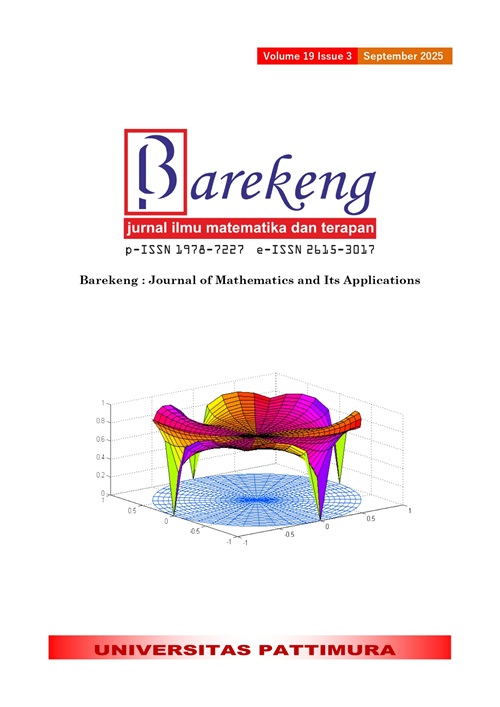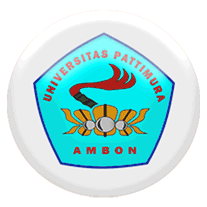PREDICTION OF AVERAGE TEMPERATURE IN BANYUWANGI REGENCY USING SARIMA
Abstract
Climate change due to human activity has significantly impacted increasing global average temperatures, including in Banyuwangi Regency, East Java. The impact is felt in several sectors, such as agriculture, tourism, and health. As a preventive measure to minimize the adverse effects that will occur in the future, an accurate prediction of the average temperature of Banyuwangi Regency is needed. This research used secondary data from the official website of the Central Statistics Agency (BPS) of Banyuwangi Regency per month from January 2012 to December 2023. Predictions are made using the seasonal autoregressive integrated moving average (SARIMA) approach. The best model is selected based on its fulfillment of stationarity, the significance of its parameters, and compliance with the assumptions of normality and white noise. From this method, the best model obtained to predict the average temperature of Banyuwangi Regency is the probabilistic SARIMA (1,0,0)(0,1,1)12. The probabilistic SARIMA model treats both parameters and forecasts as probability distributions. The average temperature of Banyuwangi Regency is obtained for the next year, namely from January 2023 to December 2023, with a MAPE of 1.63%. With an accuracy rate of 98.37%, it can be said that the probabilistic SARIMA (1,0,0)(0,1,1)12 model is accurate in predicting the average temperature of Banyuwangi Regency in the future. Thus, the prediction of the average temperature of Banyuwangi Regency is expected to help the community and government manage the impact of erratic climate change to improve the welfare of all Banyuwangi people.
Downloads
References
J. Mukono, ANALISIS KESEHATAN LINGKUNGAN AKIBAT PEMANASAN GLOBAL. Surabaya: Airlangga University Press, 2018.
D. Herlambang, “2023 BERPOTENSI MENJADI TAHUN TERPANAS, MITIGASI PERUBAHAN IKLIM HARUS DIMASIFKAN,” BADAN METEOROLOGI, KLIMATOLOGI, DAN GEOFISIKA. Accessed: Nov. 02, 2023. [Online]. Available: https://www.bmkg.go.id/berita/utama/tahun-2023-berpotensi-menjadi-tahun-terpanas-mitigasi-perubahan-iklim-harus-dimasifkan
R. Astuti, K. Saniyah, R. Anggraeni, and D. M. M.Nur, “DAMPAK LA NINA DAN EL NINO BAGI KEHIDUPAN MASYARAKAT INDONESIA,” J. Ilm. Multidisiplin, vol. 1, no. 5, pp. 69–75, 2024.
Sumarsono, “DAMPAK EL NINO PRODUKTIVITAS PADI DI BANYUWANGI MENURUN,” Radio Republik Indonesia. Accessed: Apr. 05, 2024. [Online]. Available: https://www.rri.co.id/jember/daerah/406005/dampak-el-nino-produktivitas-padi-di-banyuwangi-menurun
B. N. Ekwueme and J. C. Agunwamba, “TREND ANALYSIS AND VARIABILITY OF AIR TEMPERATURE AND RAINFALL IN REGIONAL RIVER BASINS,” Civ. Eng. J., vol. 7, no. 5, pp. 816–826, 2021.doi: https://doi.org/10.28991/cej-2021-03091692
Y. I. (Universitas J. Katabba, “METODE SEASONAL AUTOREGRESSIVE INTEGRATED MOVING AVERAGE (SARIMA) UNTUK MEMPREDIKSI JUMLAH PENUMPANG KERETA API DI PULAU SUMATERA,” 2021. [Online]. Available: https://repository.unja.ac.id/id/eprint/23229%0A
M. Asamoah-Boaheng, “USING SARIMA TO FORECAST MONTHLY MEAN SURFACE AIR TEMPERATURE IN THE ASHANTI REGION OF GHANA,” Int. J. Stat. Appl., vol. 4, no. 6, pp. 292–299, 2014.
L. H. Hasibuan, S. Musthofa, D. M. Putri, and M. Jannah, “COMPARISON OF SEASONAL TIME SERIES FORECASTING USING SARIMA AND HOLT WINTER’S EXPONENTIAL SMOOTHING (CASE STUDY: WEST SUMATRA EXPORT DATA),” BAREKENG J. Ilmu Mat. dan Terap., vol. 17, no. 3, pp. 1773–1784, 2023.doi: https://doi.org/10.30598/barekengvol17iss3pp1773-1784
A. R. Dimashanti and Sugiman, “PERAMALAN INDEKS HARGA KONSUMEN KOTA SEMARANG MENGGUNAKAN SARIMA BERBANTUAN SOFTWARE MINITAB,” Prisma, vol. 4, pp. 565–576, 2021, [Online]. Available: https://journal.unnes.ac.id/sju/index.php/prisma/
I. Machali, METODE PENELITIAN KUANTITATIF (PANDUAN PRAKTIS MERENCANAKAN, MELAKSANAKAN, DAN ANALISIS DALAM PENELITIAN KUANTITATIF). Yogyakarta, 2021.
BPS, “SUHU MAKSIMUM, MINIMUM DAN RATA-RATA SUHU BULANAN, 2011-2023,” Badan Pusat Statistik Banyuwangi. Accessed: Apr. 01, 2024. [Online]. Available: https://banyuwangikab.bps.go.id/id/statistics-table/1/MTM5IzE=/suhu-maksimum-minimum-dan-rata-rata-suhu-bulanan-2011-2020.html
S. Aktivani, “UJI STASIONERITAS DATA INFLASI KOTA PADANG,” Statistika, vol. 20, no. 2, pp. 83–90, 2020.
G. E. P. Box, G. M. Jenkins, G. C. Reinsel, and G. M. Ljung, TIME SERIES ANALYSIS: FORECASTING AND CONTROL, 5th ed. Canada: Wiley, 2015.
J. V. Dompas, J. S. Kekenusa, and M. S. Paendong, “PREDIKSI JUMLAH PENDERITA DEMAM BERDARAH DI KABUPATEN KEPULAUAN SANGIHE MENGGUNAKAN MODEL ARIMA MUSIMAN,” d’CARTESIAN, vol. 9, no. 2, p. 126, Jan. doi: https://doi.org/10.35799/dc.9.2.2020.29139
D. Deviyantini, I. Sugema, and T. Irawan, “STRUCTURAL BREAKS DAN KETIDAKSTABILAN PERMINTAAN UANG DI INDONESIA,” J. Ekon. DAN Kebijak. Pembang., vol. 6, no. 2, pp. 47–60, Jul. doi: https://doi.org/10.29244/jekp.6.2.2017.47-60
M. Arumsari and A. Dani, “PERAMALAN DATA RUNTUN WAKTU MENGGUNAKAN MODEL HYBRID TIME SERIES REGRESSION – AUTOREGRESSIVE INTEGRATED MOVING AVERAGE,” J. Siger Mat., vol. 2, no. 1, Mar.
I. Nabillah and I. Ranggadara, “MEAN ABSOLUTE PERCENTAGE ERROR UNTUK EVALUASI HASIL PREDIKSI KOMODITAS LAUT,” JOINS (Journal Inf. Syst., vol. 5, no. 2, pp. 250–255, Nov. 2020.doi: https://doi.org/10.33633/joins.v5i2.3900
Arwin Datumaya Wahyudi Sumari, Muhammad Bisri Musthafa, Ngatmari, and Dimas Rossiawan Hendra Putra, “COMPARATIVE PERFORMANCE OF PREDICTION METHODS FOR DIGITAL WALLET TRANSACTIONS IN THE PANDEMIC PERIOD,” J. RESTI (Rekayasa Sist. dan Teknol. Informasi), vol. 4, no. 4, pp. 642–647, Aug. 2020.doi: https://doi.org/10.29207/resti.v4i4.2024
D. Novriyana and F. Marpaung, “PERBANDINGAN METODE SINGLE EXPONENTIAL SMOOTHING, NAIVE MODEL, DAN SARIMA UNTUK PERAMALAN CURAH HUJAN DI KOTA MEDAN,” J. Mat. Stat. Komputasi, vol. 17, no. 1, pp. 117–128, 2020.doi: https://doi.org/10.20956/jmsk.v17i1.10236
F. Rozci, “DAMPAK PERUBAHAN IKLIM TERHADAP SEKTOR PERTANIAN PADI,” J. Ilm. Sosio Agribis, vol. 23, no. 2, p. doi: https://doi.org/10.30742/jisa23220233476
L. S. Mahabella, O. Rapija, and G. Waibo, “ANALISIS NILAI INDEKS SUHU DAN KELEMBABAN RUANG TERBUKA TAMAN REKREASI SENGKALING,” vol. 18, no. 2, pp. 75–82, 2020.
Copyright (c) 2025 Idrus Syahzaqi, Sediono Sediono, Mega Kurnia Dyaksa, Anggi Triya Vionita, Anisah Nabilah Ghasani

This work is licensed under a Creative Commons Attribution-ShareAlike 4.0 International License.
Authors who publish with this Journal agree to the following terms:
- Author retain copyright and grant the journal right of first publication with the work simultaneously licensed under a creative commons attribution license that allow others to share the work within an acknowledgement of the work’s authorship and initial publication of this journal.
- Authors are able to enter into separate, additional contractual arrangement for the non-exclusive distribution of the journal’s published version of the work (e.g. acknowledgement of its initial publication in this journal).
- Authors are permitted and encouraged to post their work online (e.g. in institutional repositories or on their websites) prior to and during the submission process, as it can lead to productive exchanges, as well as earlier and greater citation of published works.






1.gif)



